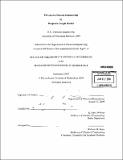| dc.contributor.advisor | K. Dane Wittrup. | en_US |
| dc.contributor.author | Hackel, Benjamin Joseph | en_US |
| dc.contributor.other | Massachusetts Institute of Technology. Dept. of Chemical Engineering. | en_US |
| dc.date.accessioned | 2010-08-30T14:44:59Z | |
| dc.date.available | 2010-08-30T14:44:59Z | |
| dc.date.copyright | 2009 | en_US |
| dc.date.issued | 2009 | en_US |
| dc.identifier.uri | http://hdl.handle.net/1721.1/57701 | |
| dc.description | Thesis (Ph. D.)--Massachusetts Institute of Technology, Dept. of Chemical Engineering, 2009. | en_US |
| dc.description | Vita. Cataloged from PDF version of thesis. | en_US |
| dc.description | Includes bibliographical references. | en_US |
| dc.description.abstract | Molecular recognition reagents are a critical component of targeted therapeutics, in vivo and in vitro diagnostics, and biotechnology applications such as purification, detection, and crystallization. Antibodies have served as the gold standard binding molecule because of their high affinity and specificity and, historically, because of their ability to be generated by immunization. However, antibodies suffer from several shortcomings that hinder their production and reduce their efficacy in a breadth of applications. The tenth type III domain of human fibronectin provides a small, stable, single-domain, cysteine-free protein scaffold upon which molecular recognition capability can be engineered. In the current work, we provide substantial improvements in each phase of protein engineering through directed evolution and develop a complete platform for engineering high affinity binders based on the fibronectin domain. Synthetic combinatorial library design is substantially enhanced through extension of diversity to include three peptide loops with inclusion of loop length diversity. The efficiency of sequence space search is improved by library focusing with tailored diversity for structural bias and binding capacity. Evolution of lead clones was substantially improved through development of recursive dual mutagenesis in which each fibronectin gene is subtly mutated or the binding loops are aggressively mutated and shuffled. This engineering platform enables robust generation of high affinity binders to a multitude of targets. Moreover, the development of this technology is directly applicable to other protein engineering campaigns and advances the scientific understanding of molecular recognition. Binders were engineered to tumor targets carcinoembryonic antigen, CD276, and epidermal growth factor receptor as well as biotechnology targets human serum albumin and goat, mouse, and rabbit immunoglobulin G. Binders have demonstrated utility in affinity purification, laboratory detection, and cellular labeling and delivery. Of particular interest, a panel of domains was engineered that bind multiple epitopes of epidermal growth factor receptor. Select non-competitive heterobivalent combinations of binders effectively downregulate receptor in a non-agonistic manner in multiple cell types. These agents inhibit proliferation and migration and provide a novel potential cancer therapy. | en_US |
| dc.description.statementofresponsibility | by Benjamin Joseph Hackel. | en_US |
| dc.format.extent | 185 p. | en_US |
| dc.language.iso | eng | en_US |
| dc.publisher | Massachusetts Institute of Technology | en_US |
| dc.rights | M.I.T. theses are protected by
copyright. They may be viewed from this source for any purpose, but
reproduction or distribution in any format is prohibited without written
permission. See provided URL for inquiries about permission. | en_US |
| dc.rights.uri | http://dspace.mit.edu/handle/1721.1/7582 | en_US |
| dc.subject | Chemical Engineering. | en_US |
| dc.title | Fibronectin domain engineering | en_US |
| dc.type | Thesis | en_US |
| dc.description.degree | Ph.D. | en_US |
| dc.contributor.department | Massachusetts Institute of Technology. Department of Chemical Engineering | |
| dc.identifier.oclc | 654110473 | en_US |
